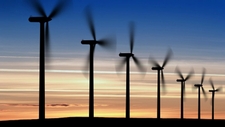Wind Power
Readiness

TEKS Objective
Identify alternative energy resources such as wind, solar, hydroelectric, geothermal, and biofuels.
Essential Understanding
The student knows Earth's surface is constantly changing and consists of useful resources.
Science Background
Wind: US Department of Energy (website) - Links to news, information, and government programs related to wind energy.
Wind
US Department of Energy's Office of Energy Efficiency and Renewable Energy, www.eere.energy.gov
Elementary Energy Infobook: The NEED Project (PDF) - Fact sheets about different uses for energy, major energy sources, renewable and non-renewable forms of energy, electricity, energy safety and saving energy.
Signature Lesson
Lesson Zap! See the Wind! The KidWind Project (PDF) - Students identify wind as an energy source and learn that wind speed and smoothness change at different altitudes above Earth. Page 3.
Lesson Zap! See the Wind!
The KidWind Project, learn.kidwind.org
Make an Anemometer! Energy Quest (website) - Students identify wind as a source of energy to generate electricity while building an anemometer that can gauge wind speed.
Make an Anemometer!
California Energy Commission, Energy Quest, www.energyquest.ca.gov
NOTE: For best results, combine both signature lessons into a single class activity.
- Supporting Lessons
- Extensions
- Assessment Ideas
- Literature Connections
- Related
TEKS - Additional Resources
Supporting Lessons
Energy Resources and Trade-Offs: Science NetLinks (website) - Students identify and investigate a variety of renewable and nonrenewable energy resources, and evaluate the benefits and drawbacks of each.
Energy Resources and Trade-Offs
Science NetLinks, www.sciencenetlinks.com
Elaboration Lessons and Extensions
Wind Is Energy: The NEED Project (PDF) – Downloadable activity guide and illustrated, nonfiction “backgrounder” text for students on wind as an energy source.
Wind Is Energy
The NEED Project, www.need.org
Renewable Energy, Wind: National Renewable Energy Laboratory (PDF) - Students learn that rotors, blades and wind speed are factors that determine how much electricity can be generated by a windmill. (Scroll to Activity 6, pages 49-54.)
Renewable Energy, Wind
National Renewable Energy Laboratory, www.nrel.gov
Energy Kids: U.S. Energy Information Administration (website) - Games, activities, animations, and text about all sources of energy, including wind.
Energy Kids
U.S. Energy Information Administration, www.eia.gov
How Does a Wind Turbine Work? GreenLearning Canada (website) - Interactive animation that shows the power output of a wind turbine in different conditions. After all boxes are completed/questions answered, students continue to a second animation that illustrates and explains the parts of a turbine.
How Does a Wind Turbine Work?
GreenLearning Canada, www.greenlearning.ca
Assessment Ideas
Have students write persuasive newspaper editorials promoting the adoption and use of wind energy in the community. Students should defend their arguments by including information learned through all the lessons on alternative energy resources.
As a possible second step, hold a mock town hall meeting in which students advocate for different alternative energy sources. Structure the activity to suit the needs of your class. It could be a simple discussion, or an assignment for which students make posters and flyers, and dress in costume. In any case, have students discuss and debate various alternative energy sources. Conclude by holding a class vote to determine which type of alternative energy the town will adopt.
Can your school support a wind turbine to provide electricity? A wind speed of three to five meters per second is required to run the turbine. Read the article about an Iowa school district to learn the power of wind.
Literature Connections
The Wind at Work: An Activity Guide to Windmills. Woelfle, Gretchen (ISBN-10: 1556523084)
Wind Power: (Energy for Today). Benduhn, Tea (ISBN-10: 0836893646)
A Refreshing Look at Renewable Energy with Max Axiom, Super Scientist, Krohn, Katherine E. (ISBN-10: 1429639024)
Wind and Water (Energy and the Environment), Tabak, John (ISBN-10: 0816070873)
Wind Power (Energy at Work). Sherman, Joseph (ISBN-10: 073685195x)
Energy Forever? Wind Power. Graham, Ian (ISBN-10: 0750233532)
TEKS Navigation
Grade 5
Need Assistance?
If you need help or have a question please use the links below to help resolve your problem.

Comments